Abstract
In the Sahel, land ownership is significantly influenced by the complexity of hierarchical, ethnic, and tribal aspects as well as communal, religious, and state rights. This complicates the development of large-scale ecological projects. This study investigates the positive and negative experiences that have changed the method and attitude of agencies in Mauritania to providing a holistic and ecosystemic approach to conservation and restoration. The physical environment and society’s perception of applied restoration measures are of great importance for reducing environmental degradation and promoting future actions. Interviews with stakeholders helped understand the social reality and impact of restoration and management measures taken on the communities. The results of this study revealed that measures such as fencing plots, preventing the passage of livestock, and stabilizing sand dunes noticeably improved the vegetative cover of the soil in the Sahel. This improvement in vegetation cover has had direct effects on the improvement of soil quality indicators such as organic carbon content, pH, soil structure, color, and texture. Different stakeholders have shown considerable involvement in projects, positively valuing their implementation and observing improvements in their daily lives.
Introduction
The Sahel region in Africa captured the attention of the global community after the occurrence of extensive and severe droughts between the ‘70s and early to mid-‘90s (Descroix et al., 2018; Nicholson, 2018; Nkrumah et al., 2019). This unprecedented period of drought had unleashed extreme social and humanitarian consequences, including an increase in soil degradation, death of livestock, famine, and the rise in armed conflicts, which initiated the first massive migrations (Suhrke and Hazarika, 1993; Trenberth et al., 2007). This has led many researchers to assess the future climate of the Sahara and promote strategies to counter its gradual southward expansion For example, Guo et al. (2023) anayzed the future climate change in the Sahara region using the projection simulation dataset of the CMIP6 multi-model ensemble. The result of this study showed that annual and seasonal average surface air temperature in the Sahara region will continue to rise throughout the twenty-first century relative to the baseline period 1995–2014 if greenhouse gas (GHG) concentrations continue increasing. After this period of severe droughts strategies and initiatives emerged to combat the inexorable advancement of the Sahara, which has been observed to be consistently expanding since satellite data became available (Tucker et al., 1991a; Tucker et al., 1991b). The Great Green Wall (GGW) of Africa is an ambitious initiative that prioritizes large-scale tree restoration as a key approach to combat desertification and improve the livelihoods of rural communities in the southern Sahara (Turner et al., 2021). The wall will be approximately 15 km wide and 8,000 km long, crossing 11 countries with rainfall regimes of 100–400 mm per year (Figure 1). It was initially an entirely African initiative, under the slogan “A project by Africa for Africans” (Hidalgo García, 2022), that became an official target of the African Union in 2007. The completion of the program is targeted for 2030, assuming that simultaneous action would be possible in all countries involved (Goffner et al., 2019).
FIGURE 1
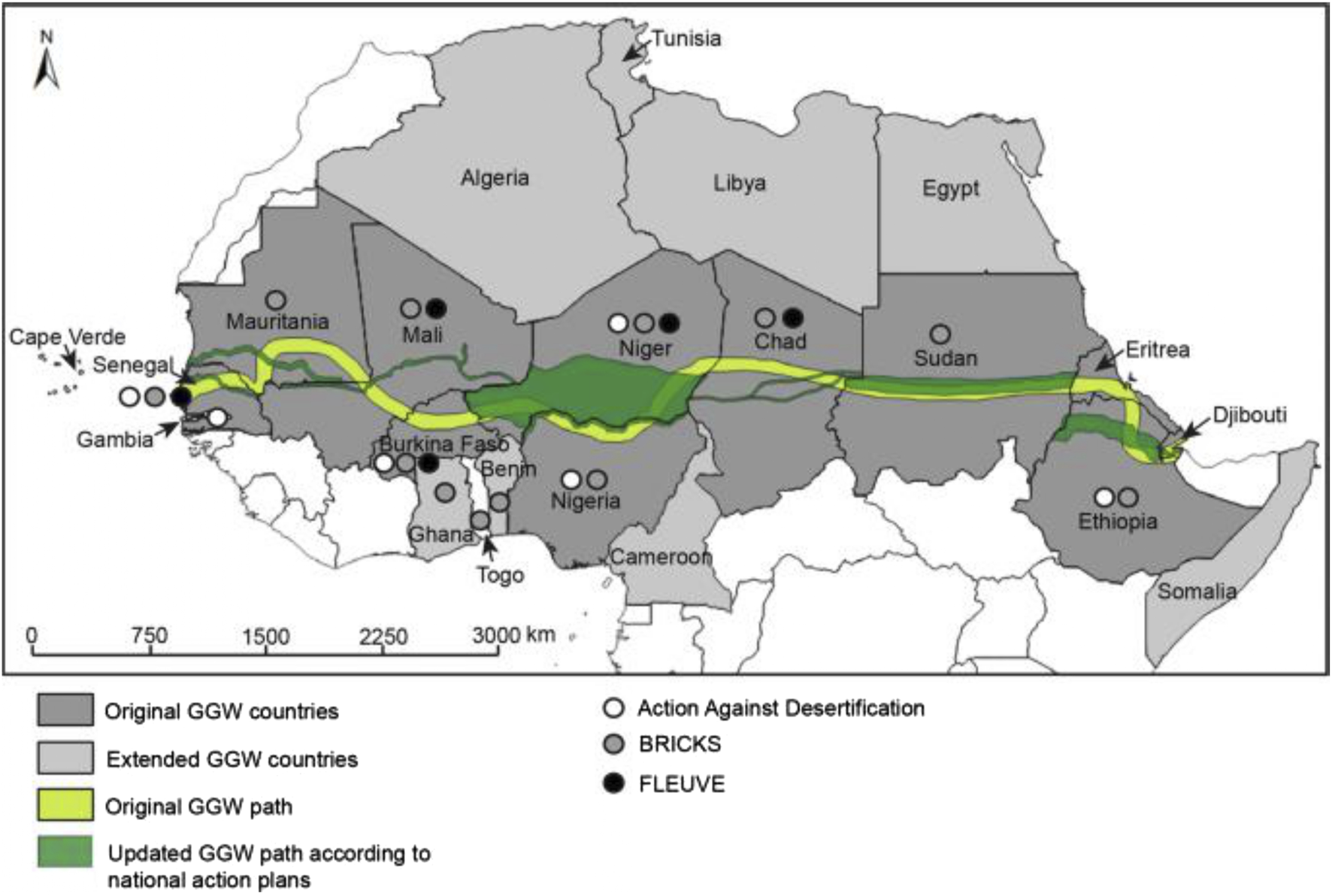
Plan evolution of the Great Green Wall published by Goffner et al. (2019) with the original (light green) and updated (dark green) approximate paths for the 11 founding countries (http://www.grandemurailleverte.org/). The GGW has progressively expanded to include 21 countries across the African continent (the additional countries in light gray) and other project with similar goals as Action Against Desertification, The Building Resilience through Innovation, Communication and Knowledge Services -BRICKS-, and The Front Local Environnemental pour une Union Verte -FLEUVE.
Restoring vegetation and forest cover can have a positive effect on temperature, rainfall, and water availability (Ellison et al., 2017; Espeland and Kettenring, 2018; Ellison, 2018). However, numerous projects have failed because they focused solely on the technical aspects of restoration and neglected the social aspects. An illustrative example on the lack of participation of the population in ecological restoration projects is the reforestation conducted by the United Nations High Commissioner for Refugees (UNHCR) in 2022 in the Mberra refugee camp (Bassikounou, Mauritania). Farmers introduced livestock into the intervened plots to graze on plant shoots which were only 1 month old (Figure 2). Local communities are not usually involved in the reforestation processes, which often lead to important changes in the use and management of the territory (Whitfield et al., 2011; Yirdaw et al., 2017). Therefore, placing obstacles in the path of the desert, such as walls of trees, was initially considered sufficient to slow and, more importantly, even reverse desertification (Ellison and Speranza, 2020). However, land management should include resilience and human welfare by considering soil–vegetation–water–atmosphere interactions (Pausata et al., 2020).
FIGURE 2

Images of livestock within reforested plots of land, taken in the reforestation plots near the Mberra refugee camp on 25 October 2022 during the consultancy work of Monitoring and Capitalization Restoration Initiatives commissioned by the UNHCR (Original Photos by M. Vieitez-García).
The GGW is now used as an umbrella term that encompasses other multinational projects related landscape restoration and social impacts. Among these are Action Against Desertification, which intends to restore drylands and degraded lands and address the detrimental social, economic, and environmental impact of land degradation and desertification; Building Resilience through Innovation, Communication and Knowledge Services, a regional project funded by the Global Environment Facility (GEF) and implemented by the World Bank; and FLEUVE (Front Local Environnemental pour une Union Verte), a European Union-funded GGW project implemented by the Global Mechanism of the UN Convention to Combat Desertification. The complex restoration of the Sahel has motivated the implementation of other interesting local projects in the region such as “Cash for Work pour la conservation des eaux et des sols/défense et restauration des sols” (adaptation au changement climatique et résilience des producteurs) by Save the Children in 2015.
Despite the greening of the Sahel, which was expected to increase water retention capacity in the soils and watersheds, runoff coefficients have continued to increase, as evidenced by numerous remote sensing studies (Fensholt and Rasmussen, 2011; Dardel, 2014; Dardel et al., 2014). This also contrasted with the maintenance of the radiation use efficiency values (Dardel et al., 2014). The discrepancies between these values are known as the “Sahel paradox” (Descroix, 2018). Episodes of flooding and flash floods, resulting from soil aridity and compaction, have led to the deterioration of cultivable lands that were once used by local populations (Descroix et al., 2018).
Traditionally, a significant portion of the rural population in the Sahel focused on nomadic livestock farming and transhumance. However, a shift towards sedentarization has been driven by various factors, such as demographic development control and taxation by government institutions and customs and animal disease controls, complicate the transboundary paths (Apolloni et al., 2019; Simonet and Carabine, 2021). Other aspects include proximity to villages or urban centers that allow for better access to education, family healthcare, commercial opportunities, and land occupied by large-scale extractive industries (Zecchini and Mattiello, 2016; Apolloni et al., 2018; Arribas, 2023). This sedentarization, which increases the concentration of the population in fixed areas, has resulted in changes in land ownership structures. In some cases, communities have been forced to acquire or lease land for subsistence agriculture, raising livestock, and permanent housing. With the growth and concentration of the population in specific areas, the pressure on natural resources such as water and vegetation has increased.
In addition to the change in social structure, for example, an estimated five heads of livestock per inhabitant graze semi-freely and feed on tree shoots or herbaceous plants from pastures in Mauritania (Africa Infomarket, 2023). Rangelands are spatially defined ecosystems dominated by grasses and grass-like plants, combined with various degrees of bush and tree cover that are predominantly grazed or browsed. They are used as natural and semi-natural ecosystems for the production of livestock, safeguarding wildlife and providing additional ecosystem services. More than nineteen million heads of cattle represent the overuse of vegetation and, therefore, expose denuded soil to erosion by wind and water (Nicolas et al., 2018).
In the Sahelian regions, in addition to overgrazing, the loss of vegetation cover is attributed to drought and illegal logging for firewood and charcoal production for cooking (Koffi et al., 2018; Yusifova and Togola, 2022). In many cases, this is the means of subsistence for a vulnerable population that has resulted in the degradation of existing ecosystems, leading to competition and tension over limited resources (Diop, 2012; Zulu and Richardson, 2013). Land ownership in this region is complex, involving hierarchical, ethnic, and tribal aspects as well as communal, religious, and state rights (Villasante De Beauvais, 1991; Jourde, 2011). This makes the development of large-scale ecological projects difficult because they often require the transfer of large tracts of tribal land for fencing, often disabling its use temporarily, thereby preventing the extraction of natural resources necessary for the population’s subsistence. These changes in land use and management, such as disabling transhumance routes used for centuries (Baldó, personal communication, 2023), jeopardize social cohesion and increase tension in highly unstable and fragile regions. Therefore, agencies implementing these ecological restoration projects must focus on social consensus because their medium- and long-term success depends on the understanding, empowerment, and ownership of the local population in managing their own resources. A limited understanding of local realities and narrow technocratic frameworks has led to the abandonment of multiple projects without positive results after the first year of financing (Turner et al., 2021).
Successful restorations in the Sahel in which local populations were actively involved in preserving the ecosystem have also been documented (Sendzimir et al., 2011; Bado et al., 2016), demonstrating the need for active societal participation. For example, Reij and Garrity (2016) investigated two large-scale farmer-managed natural regeneration projects of woody species in Africa to create new agroforestry systems that encourage farmers to spontaneously apply the practice because of their observed benefits. Based on these studies, successful projects must have qualified technical on-site personnel, design monitoring, and evaluation systems that target indicators for which data can be gathered. These should enable decision making and be well integrated into existing national institutions to allow the continuity of maintenance and use after project completion (Mechiche-Alami et al., 2022).
Positive and negative experiences have generated a change in the approach and attitude of agencies such as the Agence Nationale de la Grande Muraille Verte (ANGMV) in Mauritania, thereby providing a holistic and ecosystemic methodology (Woodfine and Jauffret, 2009; Goffner et al., 2019). Therefore, the new innovative concept of the GGW integrates ecosystem management and the socioeconomic development of local communities and populations in the territory. Prior to possible reforestation, agencies in charge must focus on the training of local populations, improvement of living conditions, and access to basic supplies. According to some authors, tree planting and landscape restoration in the Sahel are the final goals to be implemented (Behnke and Moritmore, 2016; Reij and Garrity, 2016). Therefore, the purpose of the GGW project is to promote synergies and optimal mobilization and use human, economic, and scientific resources, which would otherwise be difficult for each country or region.
To this end, the objectives of this paper are to a) present an initial evaluation of soil restoration measures in the Mauritanian GGW as a possible tool to help change the social paradigm that “nothing can be done about climate change” and b) link the social involvement as a required element for combat climate challenges and rural vulnerability.
Methodology
Site Description
Mauritania is located on the coast of the West African Sahel and has a total land mass of 1.03 million km2. Mauritania has a dry, hot, and windy climate, and is severely exposed to the effects of desertification. The majority of Mauritania receives very little rainfall throughout the year (<175 mm). The country’s southern edge, which reaches the Sahel, has a wet season controlled by the movement of the Inter-Tropical Convergence Zone (ITCZ) which oscillates between the northern and southern tropics over the course of a year. The country’s mean monthly temperature stays above 25°C year-round with the hot season occurring from May to October, with peak mean monthly temperatures reaching 33°C in June and July (Climate Change Knowledge Portal, 2023). The studied area is predominantly characterised by flat terrain with weakly developed soils (Regosols) and sand dunes (Arenosols), and dry, ephemeral river drainage systems (Fluvisols). In Mauritania, long, linear dunes often extend for tens of kilometres and sometimes reach 100 m in height (Jones et al., 2013). Arenosols can be either no soil horizon development (ARpr) or a layer with ≥15 cm thick and starting ≤50 cm from the mineral soil surface, that shows evidence of soil formation but has not a sandy loam or finer texture (ARbr). Fluvisols are young soil in alluvial deposits with 50% or more of effective base saturation (FLeu). Finally, Regosols are very weakly developed mineral soil in unconsolidated materials and 50% or more of effective base saturation (RGeu) (IUSS Working Group WRB, 2022).
Soil Sampling and analytical determinations
A representative set of 22 sites was sampled to compare the soils of restored or intervened areas with soils without conservation or restoration measures in Mauritania (Figure 3). Fifteen locations were selected in the Trarza and Brakna regions, at sites where ANGMV has conducted sand dune fixation (Oveivga and Tewmiyaa) or fencing for seedling establishment during reforestation (Awebia, Guimi, and Lougué Potié). Six locations were collected in the Gorgol region, where Save the Children conducted ecological restoration in the river and its surrounding floodplain, installing gabions in the riverbed and stone cords in the floodplain. In addition, a community vegetable garden in Moustah was sampled.
FIGURE 3
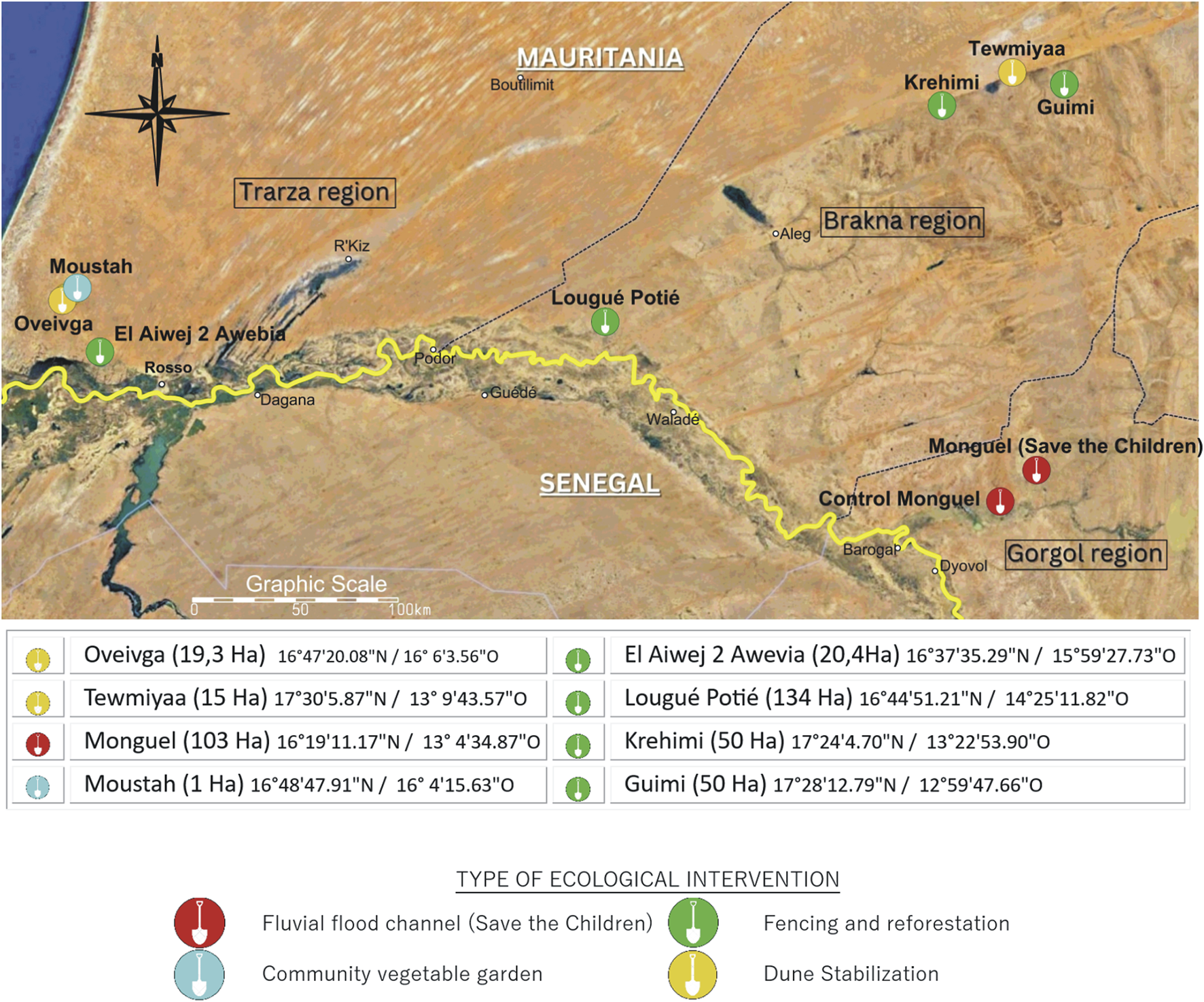
Geographical location of study area and sampling locations in the Trarza, Brakna, and Gorgol regions in Mauritania.
Soil quality assessment is increasingly incorporated in land evaluation, as land evaluation procedures are now used in many ways and purposes, including sustainable land management (Hurni et al., 2015), environmental risk assessments (Sonneveld et al., 2010) and land restoration (Schwilch et al., 2016). To evaluate the actions carried out in the study locations, different visual examinations and analysis of soil were used. Structure, soil consistence, aggregate size and shape was described as structural stability. Soil color and soil texture were included as soil physical property. Total organic carbon and pH, two of the most frequently proposed soil quality indicators (Bünemann et al., 2018), were included as soil chemical properties.
The morphological soil characteristics were described based on the FAO guidelines for soil description (Jahn et al., 2006). The thickness and Munsell color values of the dry and moist soils in each genetic horizon were compared among the samples. A homogeneous sample was extracted from each of the defined horizons up to a maximum depth between 30 and 50 cm. Air-dried soil samples were sieved (2 mm) and ground in a tungsten carbide mill. The soil particle size, organic carbon (OC) content and pH were measured. Sieves were used to separate coarse fragments (>2 mm). Organic carbon content was determined with the Walkley and Black titration method modified by Mebius (1960). Active and potential soil acidity (pH) was measured in a soil–water and KCl (1 M) suspension, respectively, with a 1:2.5 ratio and was stirred for 30 min (ISRIC, 2002). The pipette method was used to determine particle size distribution in the samples (<2 mm): coarse sand (0.2–2 mm), fine sand (0.05–0.2 mm), coarse silt (0.02–0.05 mm), fine silt (0.002–0.02 mm) and clay (<0.002 mm) (Burt, 2004).
Interviews to Project Field Managers
To assess the positive and negative experiences and perceptions during the restoration measures in the Mauritanian GGW, interviews were conducted and recorded with the Field Chiefs of ANGMV in Brakna and Trarza regions. Moreover, two women, as a manager of the community gardens implemented by the ANGMV in Brakna, were also interviewed. Technical difficulties prevented the increase in the number of interviews with the local population. Therefore, interviews were carried out with the local managers and representatives involved in the projects. The interviews focused on people’s impressions of the project’s influence on their lives and communities. Land tenure, the governance of rehabilitated places, and inclusion of aspects of greater vulnerability to society were also discussed and recorded in a documentary video for dissemination1.
Analysis of Restoration Measures
Sand Dune Fixation
The movement of the dunes in this region of the Sahel has become a problem of national importance because, in addition to deteriorating scarce infrastructure such as roads, it buries entire communities along its path (Figure 4), accelerating the migration of processes in the Sahel generated by climate change (Sinclair and Fryxell, 1985; Oyebande and Odunuga, 2010). Therefore, one of the main research targets of ANGMV is to secure sand dunes. ANGMV has performed various actions to stabilize the surface and reduce wind speed in these control areas, such as mechanical fixation by a 20 m × 20 m grid made with two species of shrubs who works as wind-break barriers (Figures 5A, B). The two species commonly used are Leptadenia pyrotechnica or Euphorbia balsamifera (Figures 5C, D). Inside the 20 m × 20 m grid a mechanical fixation of the dunes is performed by transplanting seedlings of Acacia senegal, Acacia raddiana, or Panicum turgidum before the rainy season, during the month of September. These plants germinated and were cared for by local people hired by ANGMV (Figures 5E, F). Good planning is necessary for the success of the initiative because rainfall is very scarce and the success of the project depends on it.
FIGURE 4
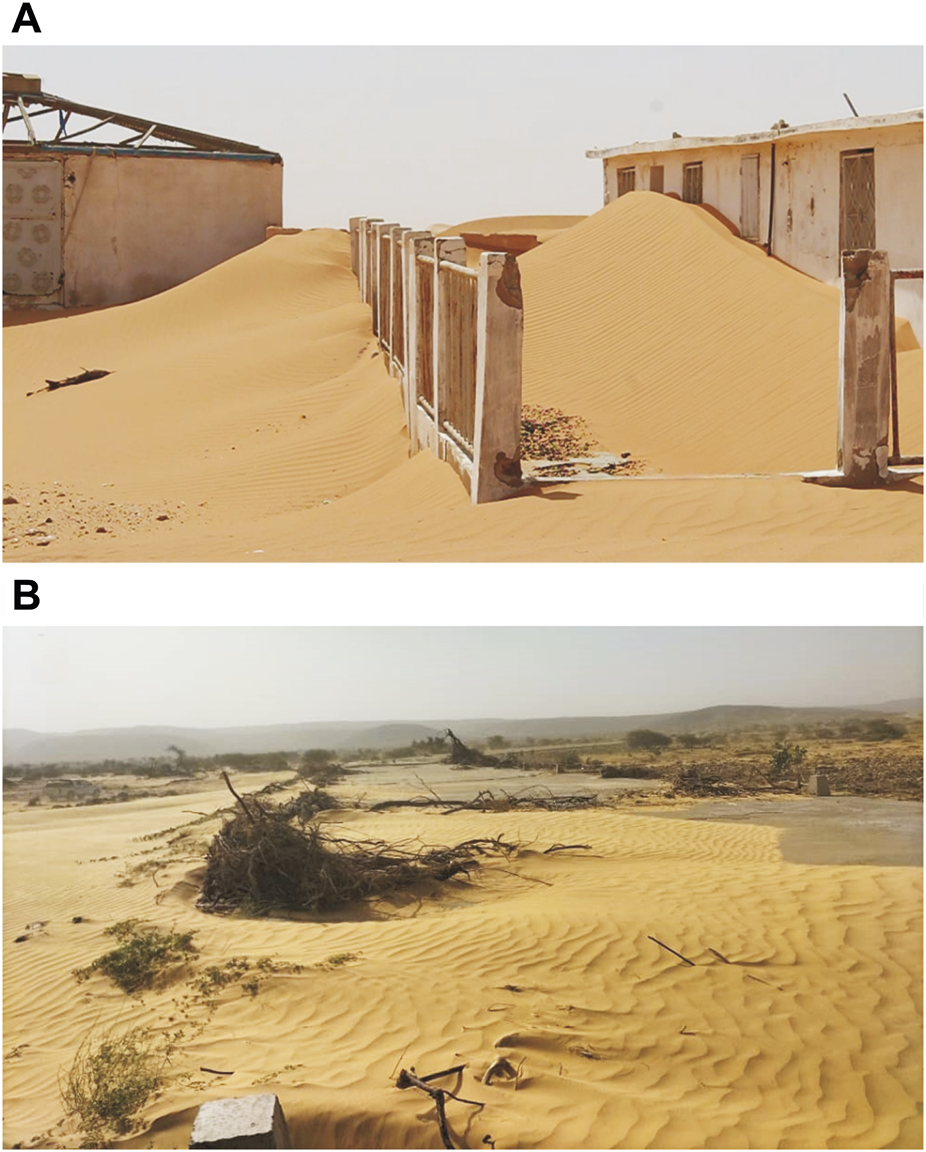
Burial of facilities such as (A) houses 30 km northeast of Nouakchott, (B) road near Tiyikya in Tagant due to sand dune movement (original photos by M. Vieitez-García and Benedicte Ginestet).
FIGURE 5
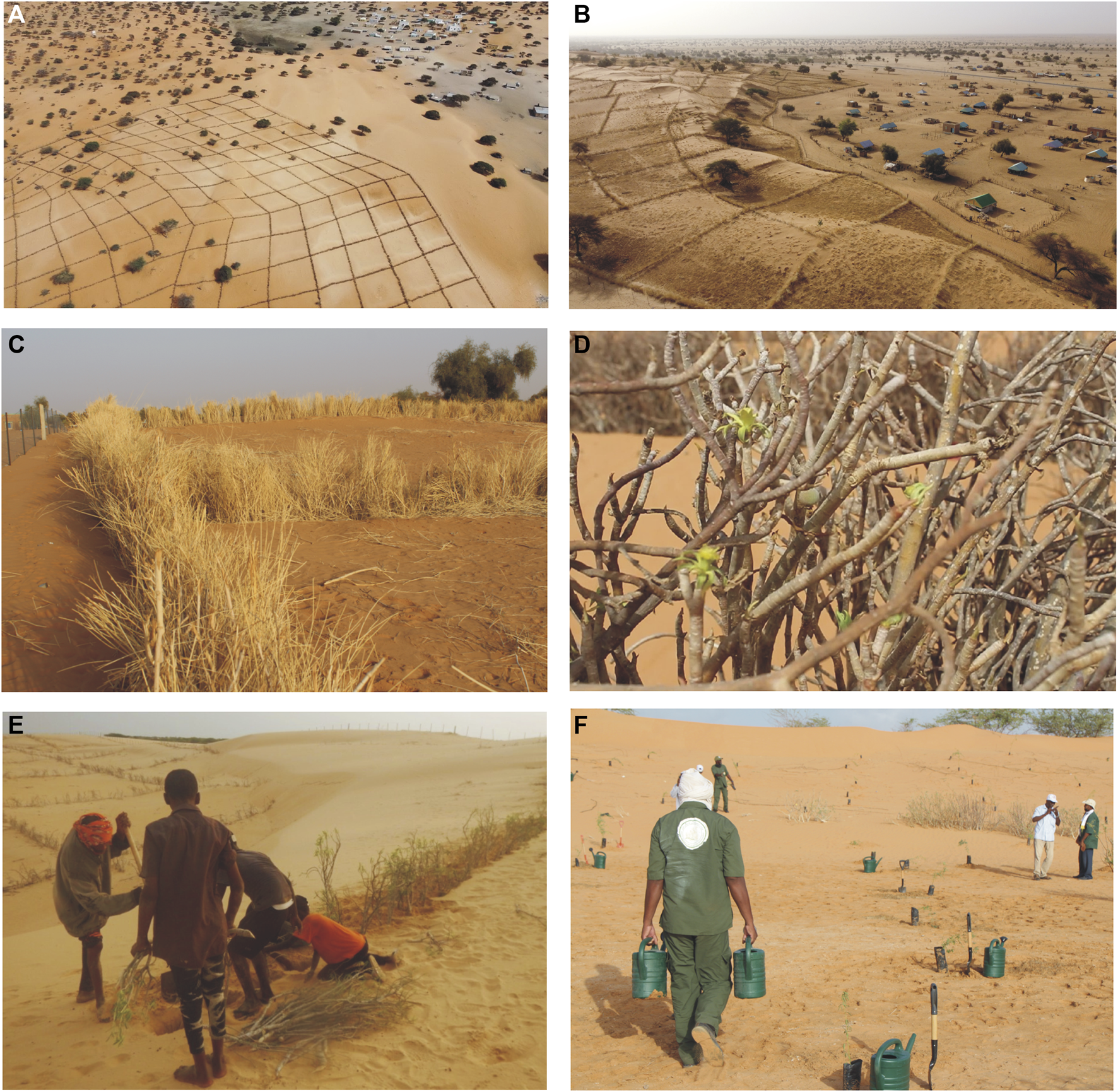
Sand dune fixation. (A,B) Grid with shelterbelt afforested for sand dune fixation in Oveivga (Trarza region) and Toumilla (Brakna Region), respectively. (C,D) Different plants species have been chosen for the shelterbelt, including Leptadernia Pyrotechnica and Euphorbia Balsamífera, respectively, (E) Conservation and restoration actions in Boutilimit, and (F) Reforestation inside of plots in Nouakchott green belt (northern part) by transplanting seedlings before the rainy season, during the month of September (original photos by M. Vieitez-García).
The Guimi, Tewmiyaa and Zamur plots were executed in 2019, and in only 4 years, the positive impact produced on the landscape can be observed, particularly the retention of sand particles that prevent their advance towards the populated areas, and the increase in vegetation cover that favors the presence of small soil aggregates associated with the development of plant roots.
No differences were observed in the soil texture, with values < 3% (2.5 ± 0.4) in the clay fraction and a sand soil textural class (Figure 6). However, slight changes in OC content were detected in the oldest interventions, with values of 0.14 ± 0.03 (Figure 7). Although they had low values when compared with cultivated soils, the favorable effect of the intervention in a very short study period is relevant. The three sampled points in the dune fixation zone have a pH of 8.23 ± 0.16 compared with 8.47 in the soils in the area without restoration (Figure 7). A considerable decrease was produced by an increase in organic matter in the soil.
FIGURE 6
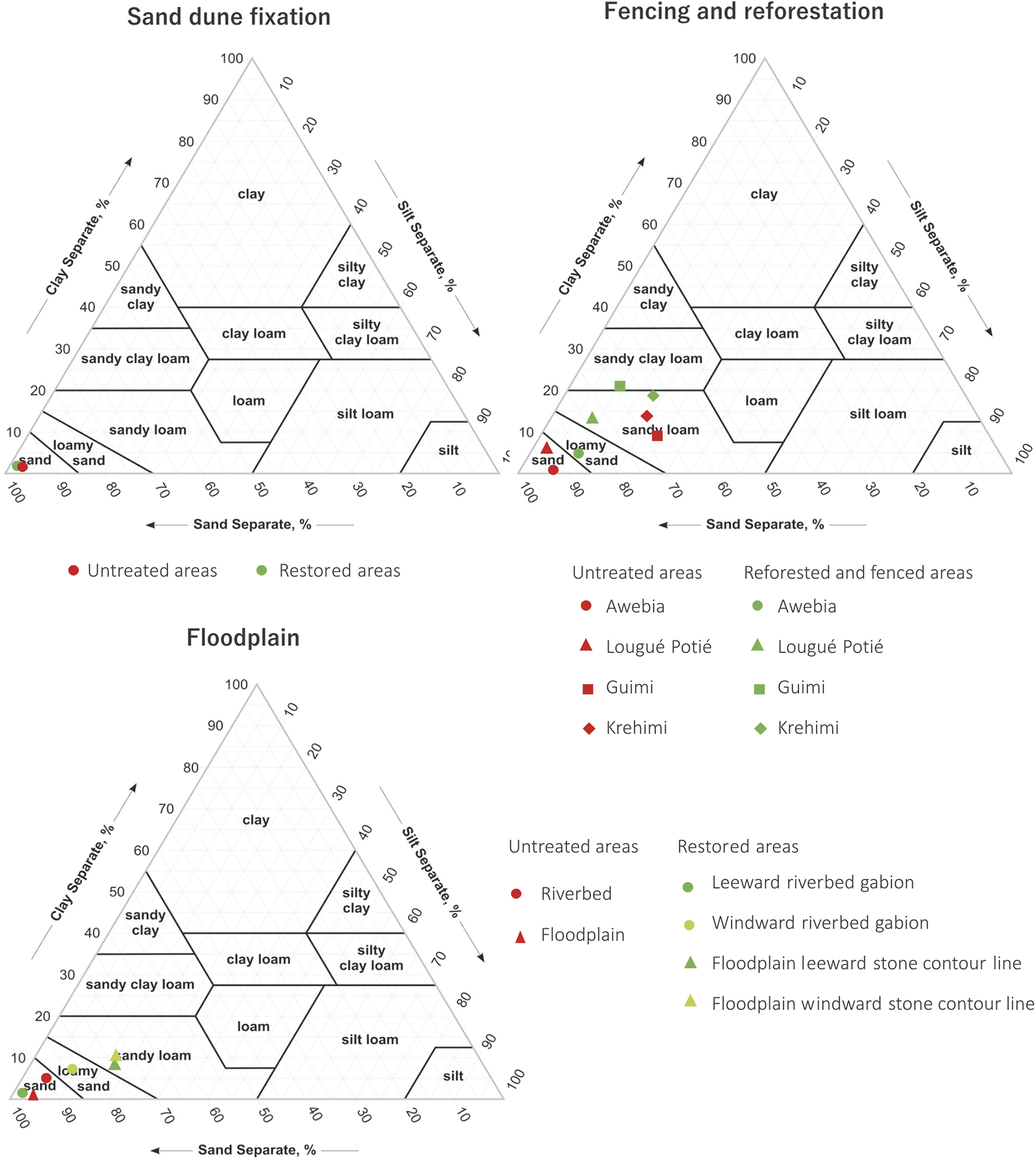
Soil Texture graphics comparing the soils of restored or intervened areas with soils without conservation or restoration measures.
FIGURE 7
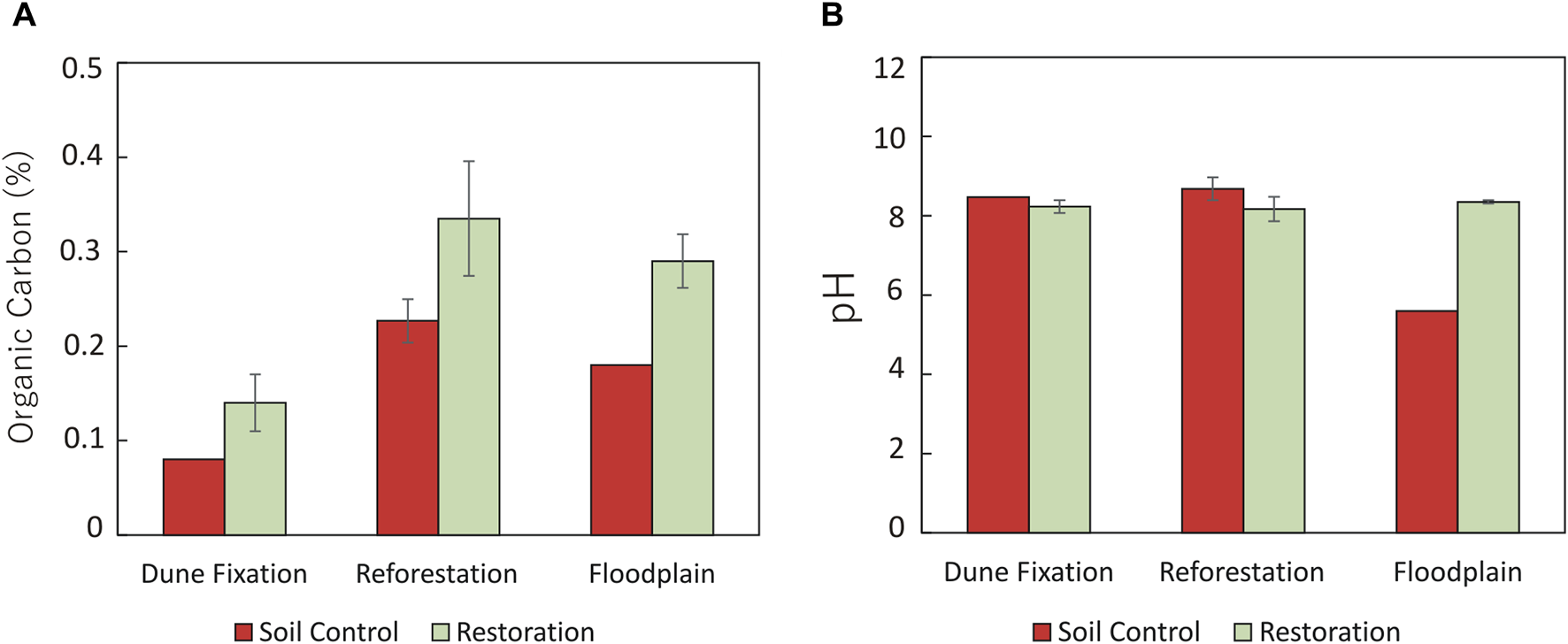
Soil chemical properties. (A) Distribution of organic carbon (OC) and (B) Soil pH values comparing the soils of restored or intervened areas with soils without conservation or restoration measures.
Fencing and Reforestation
The capacity of rangelands to sustainably supply the livestock sector in Mauritania has been overexploited. In addition, a significant proportion of forests and shrub savannas are under severe threat. Therefore, one of the measures implemented to facilitate the development of these ecosystems is the physical fencing of large areas to prevent human and livestock access (Figure 8A). The reforested and fenced areas in Awebia, Guimi, and Lougué Potié exhibited remarkably dense herbaceous cover within the plots (Figures 8B–D). The reforestation strategy begins with the dispersal of seeds from different tree species, followed by the rapid growth of herbaceous plants and development of native trees that sporadically sprout within the plot. The species used in the plantations include Balanites aegyptiaca, Ziziphus mauritiana, and A. raddiana, which are abundant in the area. The dimensions of the fenced areas ranged from 2 ha to 50 ha.
FIGURE 8
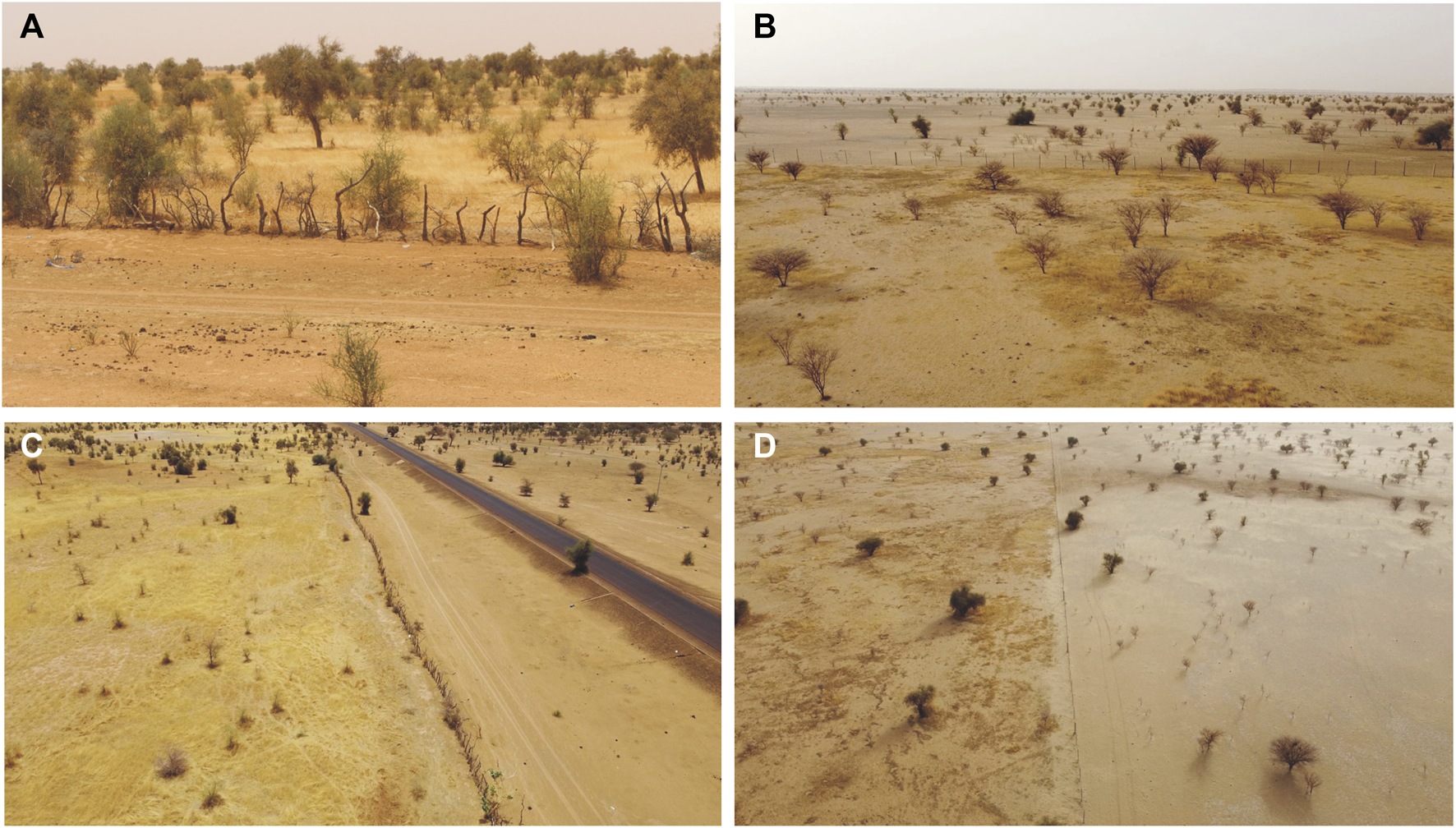
Evidence of vegetation cover development in the enclosures established within the GGW project: (A) front view of closure in Lougué Potié, (B,D) aerial views of the enclosure in Krehimi and (C) aerial view of Lougué Potié (original photos by M. Vieitez-Garcéa).
Restored soils have an incipient differentiation of horizons in the soil profiles of Lougué Potié and Guimi, especially with the formation of a structured, darker-colored surface horizon A (Table 1). Field evidence of improved soil health include the common presence of medium and fine roots, as well as galleries, resulting from the biological activity of mesofauna in the shallow surface horizons (<5/6 cm) of the soils in Lougué Potié and Guimi (Figure 9). A greater number of aggregates, larger size, and slightly hard-to-very hard consistency were observed.
TABLE 1
| Location | Depth (cm) | Dry color | Moist color | ||
|---|---|---|---|---|---|
| Control area | Restorested soils | Control area | Reforested soils | ||
| El Aiwej 2 Awebia | 0–25 | 7.5YR 6/3 | 10YR 4/4 | 7.5YR 4/3 | 10YR 3/3 |
| Lougué Potié | 0–5 | 7.5YR 4/4 | 7,5YR 4/6 | 7.5YR 2,5/3 | 7.5YR 3/3 |
| 5–25 | 10YR 4/3 | 10YR 3/2 | |||
| Guimi | 0–6 | 7.5YR 5/4 | 10YR 4/4 | 10YR 3/3 | 10YR 3/3 |
| 6–25 | 10YR 5/4 | 10YR 4/3 | 2.5Y 3/3 | 10YR 3/2 | |
| Krehimi | 0–25 | 2.5YR 4/6 | 5YR 4/6 | 2.5YR 3/4 | 7.5YR 3/4 |
Determination of soil colour measured by comparison with a Munsell Soil Book in 4 sites with one representative soil (Control area) next to the reforested soils.
FIGURE 9
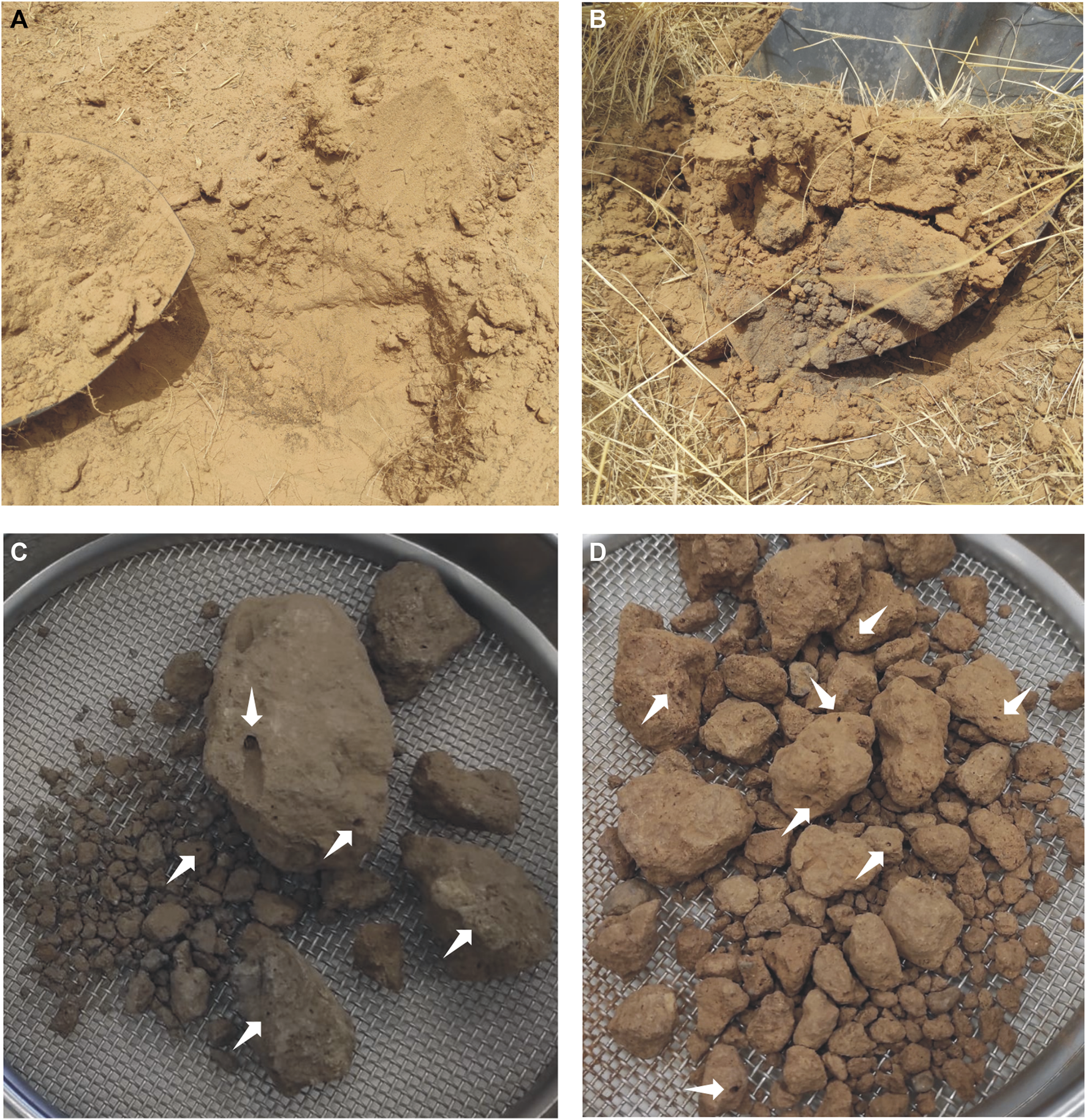
Field observation of aggregate formation. (A) Aggregates are barely observable in control site in the Lougué Potié area and when gently disturbed, the soil material breaks into a mixture of few entire aggregates and much material without aggregate faces. (B) Intervened zone for reforestation in the Lougué Potié area with soil structure development and organic matter content. When disturbed, the soil material breaks into a mixture of many entire aggregates, some broken aggregates, and little material without aggregates faces. Aggregate formation with galleries from biological activity in reforested soils: (C) medium to large aggregates with hard consistency in the top 25 cm of the sampled soil in Krehimi and (D) medium and fine aggregates at a depth of 6–25 cm in soils in Guimi (original photos by M. Vieitez-García).
Textural differences were also observed between the four sites studied. In all cases, textural classes were sandier in the untreated plots (sandy–sandy loam) than in the treated plots (sandy loamy–sandy clay loam) (Figure 6). The difference between the sands varied between 5% in Krehimi and 17% in Lougué Potié. An increase in clay content was observed in all cases, again being the lowest in Krehimi and highest in Lougué Potié. Preliminary analyses showed 1.4% more coarse fragments and 0.90% more sand in untreated plots. Wind erosion affects the selection of soil particles, which in the long term may produce textural changes in the topsoil (Chepil, 1957). This small variation in texture over such a short period is a highly relevant result. Wang et al. (2015) reported that some reversal of aeolian desertification occurred in parts of the northern China agro-pastoral zone because of sustainable and effective measures adopted and implemented in local regions (Wang et al., 2015). Fine soil particle content contributes to the development of soil structures that are resistant to wind erosion, thereby decreasing aeolian transport rates (Wang et al., 2013).
The differences in OC content were small, with average values of 0.34 ± 0.06 in the reforested areas and 0.23 ± 0.02 in the control areas; however, they already reflect a trend towards increased soil OC (Figure 7). These small differences were observed over a very short time interval since the last documented intervention was performed in 2021. These data are promising as they show a positive ecosystem response. The positive effect of increased biological activity is also evident in the variation of pH values (Figure 7), with an average of 8.2 ± 0.31 in the reforestation areas and 8.7 ± 0.29 in the external or control areas.
Floodplain Restoration
The “Cash for Work pour la conservation des eaux et des sols/défense et restauration des sols” of the Save the Children project in Monguel (Gorgol) is located in a watershed where various actions have been conducted (Figure 10), including the installation of a series of gabions in the riverbed to reduce water velocity and flood the surrounding plains. These installed gabions seem to favor the accumulation of fine particles (silt + clay) in the leeward side, although the values do not exceed 13% of that in the untreated area, despite being very sandy areas (Figure 10B). No relevant differences were observed on the windward side of the structure. Additionally, a dam was constructed to promote water infiltration into the soil and help store water after periods of heavy rainfall (Figure 10C). A stone contour line (stone raws) or cordon Pierreux approximately 10–20 cm high was placed on the Monguel village plain, following the contours of the terrain (Figure 10D). These stone contour lines aid in the settling of fine particles and reduce wind erosion during the dry seasons, all within a fenced perimeter of 100 ha (Figure 10A), reducing livestock access and allowing for the development of vegetation cover, which generates multiple benefits for the soils as soil organic matter increases.
FIGURE 10
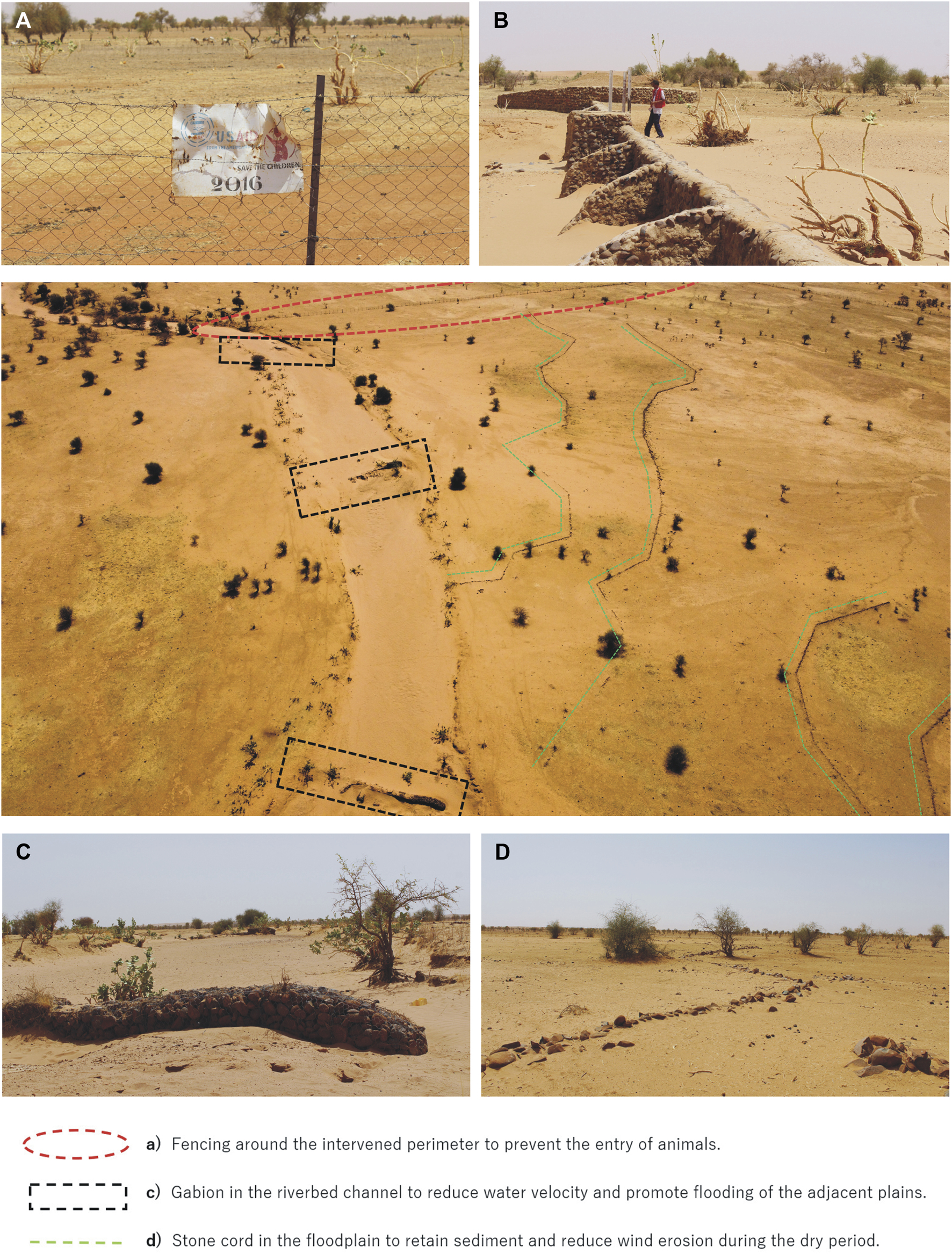
Oblique drone image of the riverbed and surrounding plains in Monguel village (Gorgol region) worked on by the Save the Children project in 2015: (A) fencing around the intervened perimeter to prevent the entry of animals, (B) dam or dike to retain and store water after the rainy season, (C) gabion in the riverbed channel to reduce water velocity and promote flooding in the adjacent plains, (D) stone cord in the floodplain to retain sediment and reduce wind erosion during the dry period (original photos by M. Vieitez-García).
In the floodplain, the samples from the treated area had a sandy–loam textural class compared with the sandy texture in the untreated area (Figure 6). The floodplain also shows an increase in soil OC (Figure 7), which reflected a greater structural development of the soil and darker tones (10YR 5/6 dry and 10YR 3/6 wet) compared with other points on the plain where no intervention has been conducted (10YR 7/4 dry and 7.5YR 4/4 wet). However, despite encouraging analytical results, the project has not been maintained over time and has been abandoned for years. Perimeter fencing was severely deteriorated in some areas as restored plot of the Save the Children project in Monguel (Gorgol region) or Bassikounou (Figures 11A, B). Another example was the gabions in the riverbed channel near Monguel village that were destroyed after the 2017 floods (Figure 11C). Restoring these measures is necessary because the aim of this project was to improve the soil quality in the floodplain for the subsistence practices of the inhabitants of the Monguel.
FIGURE 11
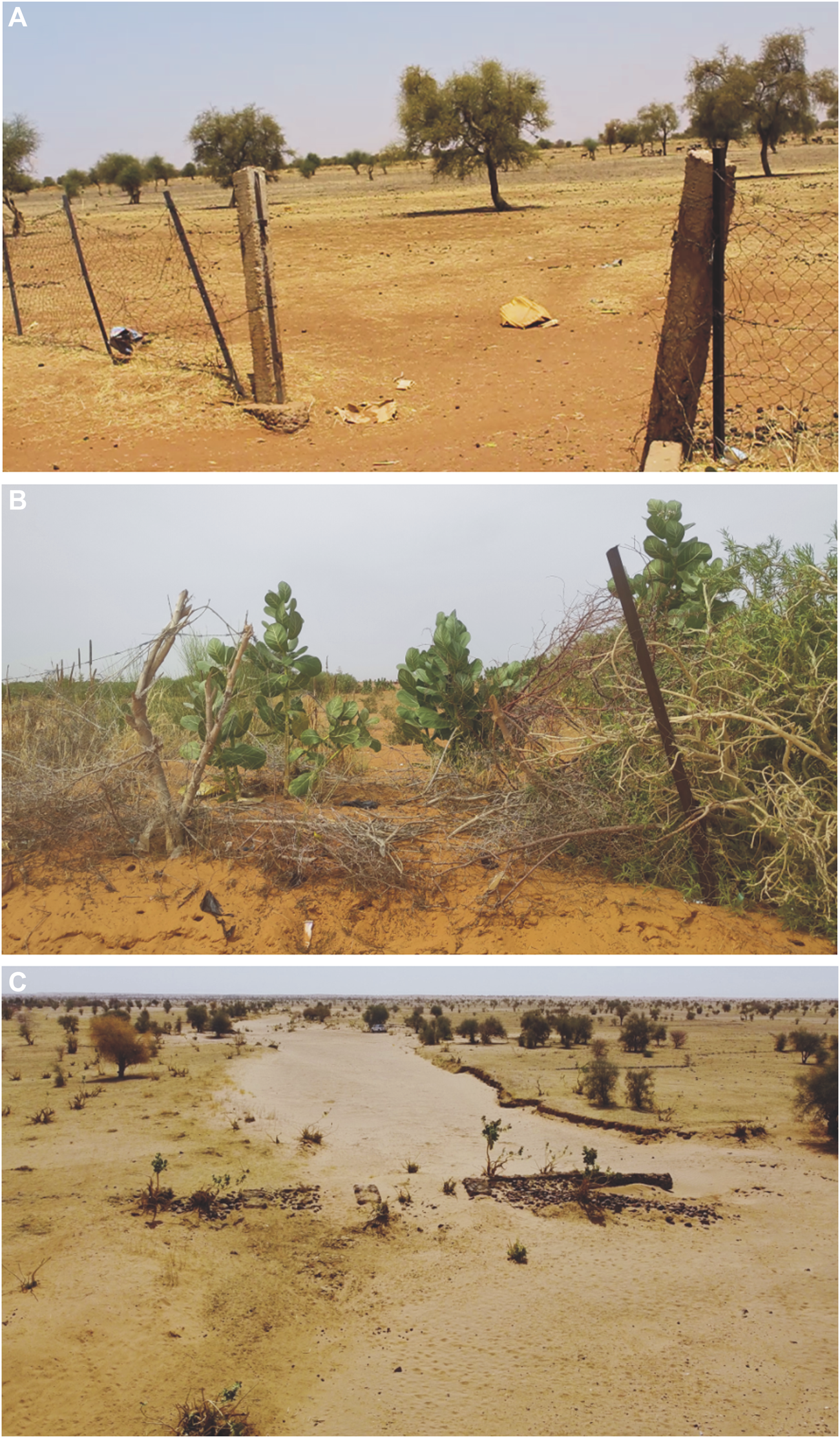
Examples of deteriorated infrastructure. Two examples of broken fencing: (A) entrance to the restored plot of the Save the Children project in Monguel (Gorgol) showing the damages to the fencing and passageways without an access gate and (B) broken fence reflecting the need for fence maintenance in Bassikounou. (C) Aerial image of a damaged gabion after an important flooding event in the floodplain of Gorgol (original photos by M. Vieitez-García).
Community Gardens
Another strategy applied in the study area was the development of community gardens as Moustah community garden (Brakna), Tewmiyaa community garden (Traza) and Guimi community gardens (Brakna) (Figure 12). Supporting rural dwellers to produce more food on their own could be relevant in reducing the push factors of migration, increasing job creation, and combating land degradation. As an example, preliminary sampling was conducted at the Moustah Point, where community gardens were implemented. The texture of the soils within the community gardens and in the untreated areas were similar, with values between 66% and 82% sand and 12% and 14% clay. No relevant differences were observed in the OC content (1.3 ± 0.2) of the topsoil (0–30 cm). However, greater biological activity was observed in the community garden soils. A greater presence of roots and small worm galleries favor the formation of larger and more consistent aggregates. These soils did not have salinity problems, although the soils outside the community gardens had a slightly alkaline pH (8.7). The growing biological activity and amendments applied to the soil helped to slightly decrease the pH (7.7 ± 0.5).
FIGURE 12
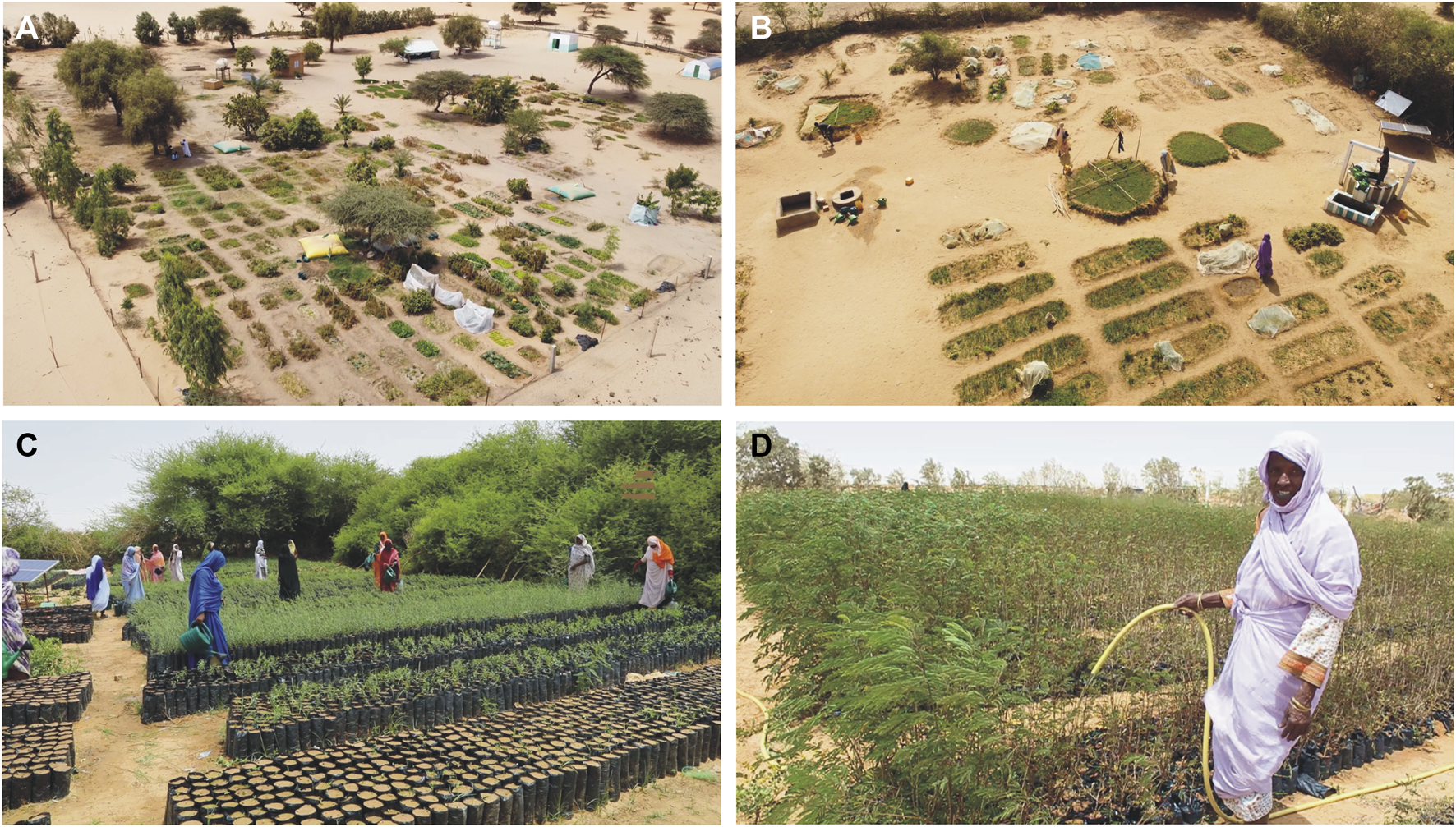
Development of agricultural communities. (A) Aerial view of the Moustah community garden (Brakna) and (B) community garden in Towmiya (Trarza). Activities in community gardens are developed exclusively by women: (C) community gardens in Guimi and (D) forest nursery at PK17 (original photos by M. Vieitez-García).
Stakeholder Participation and Perceptions
Goossen (2020) reviewed guidelines on how to involve local communities in nature conservation projects in the GGW of Africa and found that from the 20 documents that specified decision-making, implementation, and maintenance phases, only nine documents mentioned the importance of involving local communities in the decision-making phase and nine documents mentioned all three of the phases. Currently, the population’s involvement or knowledge regarding the benefits of reforestation management is scarce. For example, any medium-term management plans for installed fences have been implemented. However, new strategies are currently being incorporated into the GGW of Mauritania, including the access of local communities to credit, payment for ecosystem services, increasing land tenure security, supporting local business opportunities, providing better access to markets, increasing local alternative income, and strengthening local governance. Increasing the stakeholder ownership of processes and resources at different levels is at the core of the GGW Initiative.
These new strategies and actions provide a positive assessment of the different local stakeholders (Figure 13). The positive consequences of recent actions, such as the fixing of dunes and the fencing of some areas, are discussed in an interview conducted by one of the authors with Brahim Beikem, the Field Chief of ANGMV in the Brakna region (Figures 13A). Mr. Beikem highlights dune fixation as an important strategy because it prevents the exodus of small villages covered by sand, especially young people, and even nomadic populations. An increase in the population of certain communities allows for local economic activities with small shops and businesses. Mr. Beikem also perceived the positive results of the preliminary soil study, in which overgrazing was avoided and reforestation activities began. The protection of certain areas has increased the collection of certain seeds or gum arabic that can be marketed as natural thickeners (Figure 14) as well as improved the quality and quantity of crops. He emphasized that these fences must be changed in relatively short periods because they deteriorate rapidly as mentioned before. This confirms the positive assessment of the community regarding the efforts made by ANGMV to implement changes, highlighting the significant impact on its population resulting in changes to the quality of life of many people. This has increased the stability of the communities and the feeling of connection with the territory.
FIGURE 13
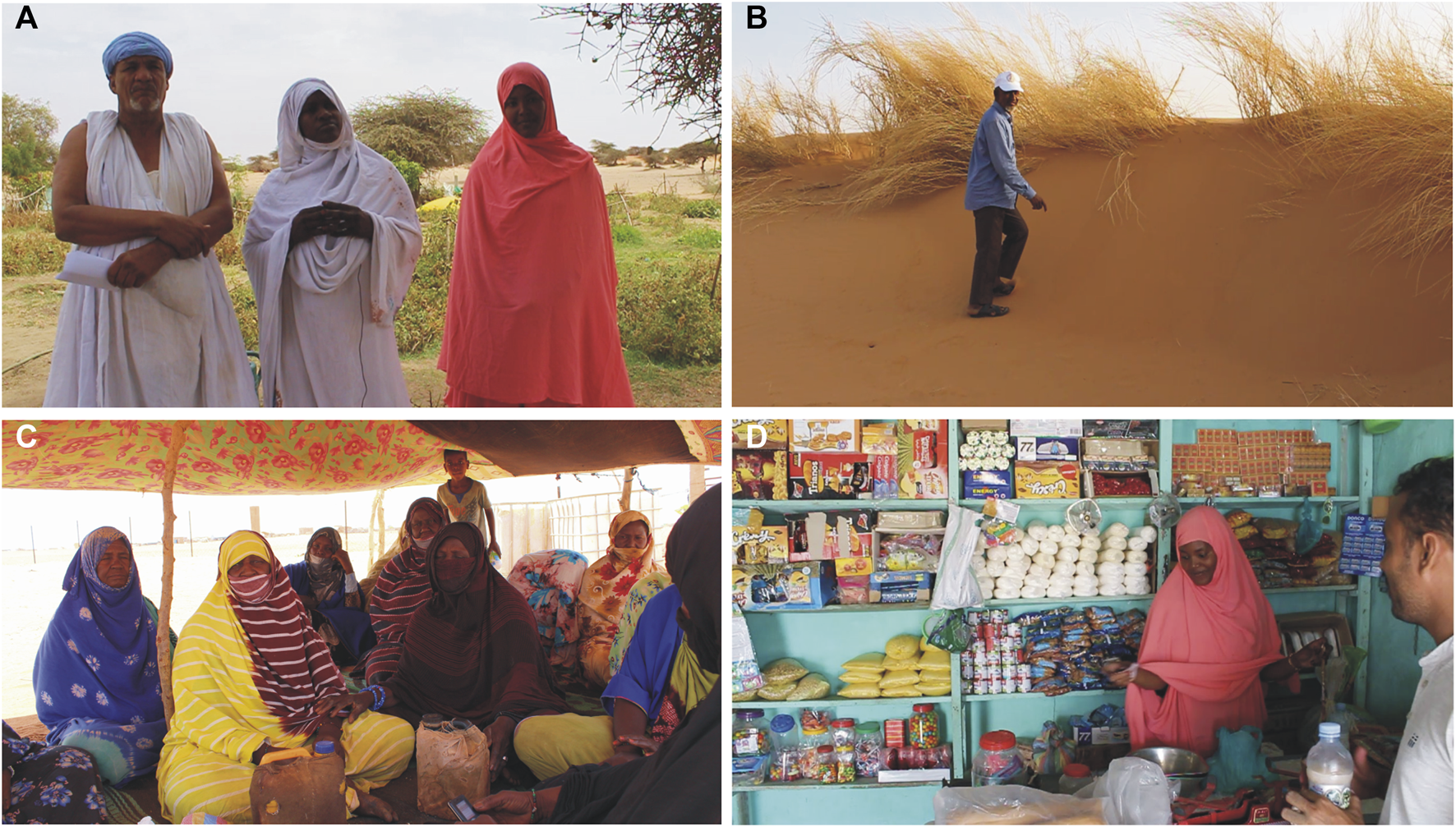
Local stakeholders: (A) Brahim Beikem (ANGMV Field Manager in Brakna) with Aisha and Fatimata (manager of the Moustah community gardens) during the field interviews and (B) Mohammed Sueilan (ANGMV field manager) inside a plot where dune fixation has been conducted in the Trarza region, (C) Monguel Women’s Cooperative and (D) commerce self-managed by the local population with the help of the ANGMV (Moustah Village) (original photos by M. Vieitez-García).
FIGURE 14
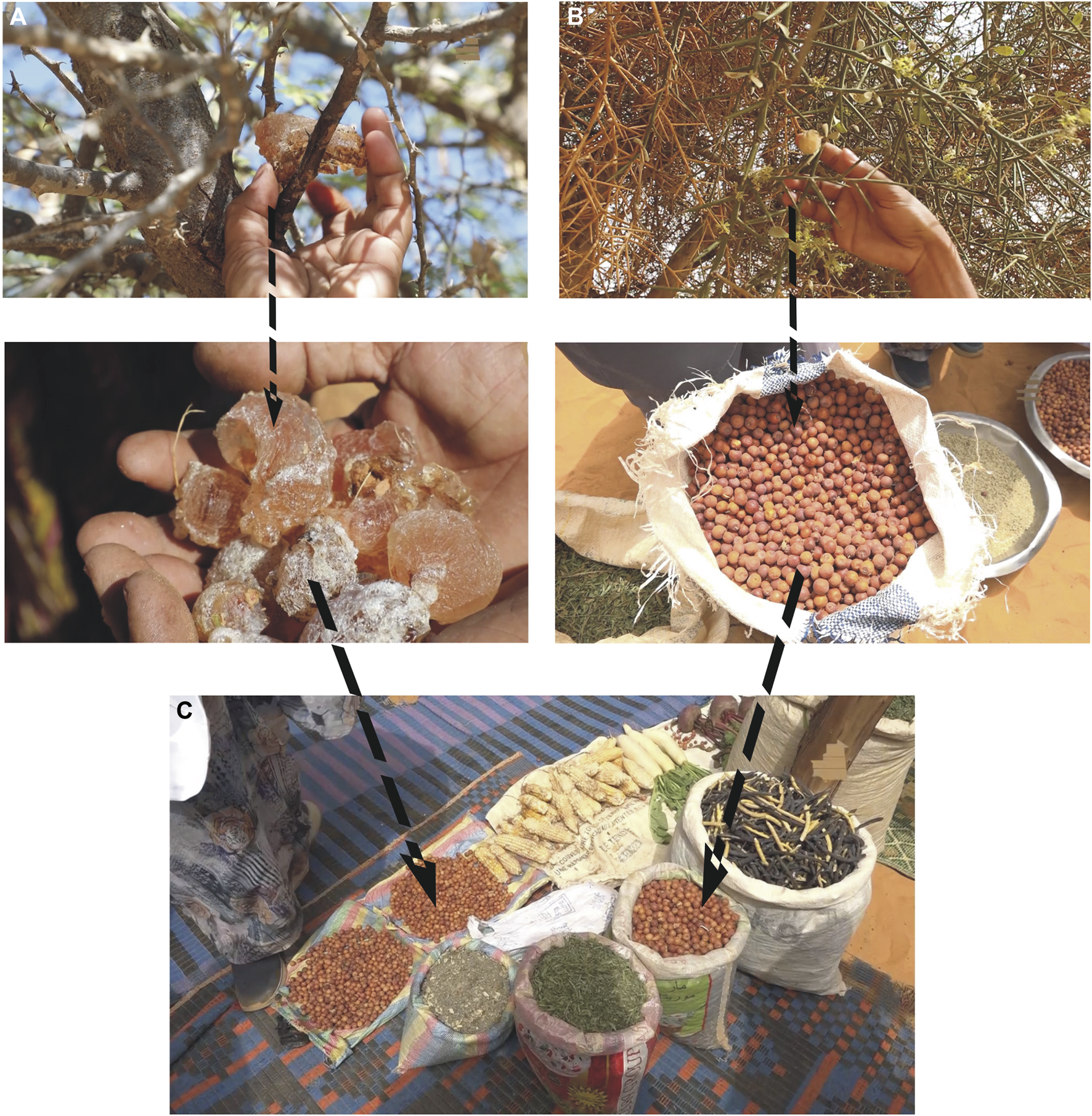
Collection of (A) gum arabic and (B) fruits of Balannites Agyptiacaca in Kaedi (Gorgol), (C) other fruits and seed from different community gardens, Kaedi (Gorgol) (original photos by M. Vieitez-García).
In Zamur, where a 20 ha intervention was conducted to protect the town from the movement of the dunes, Mr. Mohammed Sueilan (Figure 13B), an ANGMV Field Manager in the Trarza region, revealed the changes resulting from the restoration. These important changes allowed the population to be stabilized in their houses. Mr. Sueilan highlighted that this initiative of the Mauritanian state was being adopted by many other countries in the Sahel. Nevertheless, the reforested hectares must be delimited perfectly because a large amount of money, mostly from international investments, has been invested in the project (approximately €2,500 per hectare). He also highlighted community garden projects being developed in this region. All fruits and vegetables produced were sold in local community stores (Figure 13D). ANGMV provides the seeds and all materials (rakes, watering cans, baskets to collect water, pumps for the wells, etc.).
The interview with Ms. Aisha (Figure 13A), as a Manager of the Community Gardens implemented by the ANGMV in Brakna for the last 6 years in Brakna, reinforces the importance of these actions in the life of the community because the crops are produced and marketed locally (Figures 13C, D). Seeds and organic amendments, such as compost, are provided by national and international organizations. This activity is developed exclusively by women, which allows them to revalue their weight in society, improve their self-esteem, and avoid social isolation. However, Ms. Aisha also expressed some problems with diseases in the crops and the low quality of sandy soils.
Generally, ecosystems cannot be separated from social systems; rather, they should be viewed as “interactive systems.” Just as humans have an increasingly significant impact on ecosystems worldwide, ecosystems are vital for the functioning of human systems through the ecosystem services they provide. Therefore, in the processes of restoration and conservation of these “interactive systems,” more attention should be paid to the importance of involving society in the debate and participation in these actions as a guarantee of long-term success in large-scale environmental projects (Swart et al., 2018). This begins by promoting a long-term vision within all promoting entities, such as international and national agencies and NGOs. Not only must local communities be involved but long-term sources of funding must also be established to support long-term monitoring or advisory services and enable occasional assistance in case of deviations from the objectives. Therefore, generating awareness about these types of projects is necessary to inform stakeholders of their current status and generate interest in society.
Conclusion
The preliminary results obtained in the present study show a notable improvement in the vegetation cover of the soil after fencing, preventing the passage of livestock, and dune fixation in this region of the Sahel. This improvement has had direct effects on soil quality indicators such as OC content, pH, soil structure, color, and texture.
Currently, environmental restoration proposals related to ANGMV in Mauritania have evolved by incorporating social aspects to involve society in their development and success in the medium and long term. Different local stakeholders have shown considerable involvement in the projects, which have positively valued their implementation and improved the daily lives of the communities. Nevertheless, these ecological restoration projects linked to the GGW still lack qualified technical personnel and a monitoring and evolution system that can evaluate the results obtained.
Statements
Data availability statement
The raw data supporting the conclusion of this article will be made available by the authors, without undue reservation.
Ethics statement
Written informed consent was obtained from the individual(s) for the publication of any potentially identifiable images or data included in this article. All people have authorized the dissemination of their image in this article for the dissemination of obtained results.
Author contributions
All authors listed have made a substantial, direct, and intellectual contribution to the work and approved it for publication.
Funding
The author(s) declare financial support was received for the research, authorship, and/or publication of this article. The publication of this article has been partially funding by the University of Barcelona.
Acknowledgments
The authors are grateful to the entire ANGMV staff, especially the current director Sidna Ould Ahmed Ely, and the former director Mohamed el Houssein Med Legra and Yely Diawara and Diallo Oumar for providing support and access to the study sites. The assistance of Abdallahi Mohamed and Abdallahi Rabah, students of environment and sustainable development at the University of Nouakchott, was essential in developing field sampling. The entire Save the Children staff, especially the current head of mission Kodjo Paniah, and the former head of mission Siw Dörte Diallo, also the logistics and security assistant Moctar Samba Sow, who gave us access to the Save the Children project in Gorgol. Finally, we thank Marc Niñerola Hähnl and Jose Manuel Baldó for their help and advice throughout the process.
Conflict of interest
Author MV-G was employed by ETS-BAREC Environmental Studies Consultancy.
The remaining author declares that the research was conducted in the absence of any commercial or financial relationships that could be construed as a potential conflict of interest.
Footnotes
References
1
Africa Infomarket (2023). República Islámica de Mauritania. Available at: https://www.africainfomarket.org/paises/principales-sectores/mauritania/136 (Accessed September 14, 2023).
2
Apolloni A. Corniaux C. Coste C. Lancelot R. Touré I. (2019). “Livestock Mobility in West Africa and Sahel and Transboundary Animal Diseases,” in Transboundary Animal Diseases in Sahelian Africa and Connected Regions. Editors KardjadjM.DialloA.LancelotR. (Springer), 31–52.
3
Apolloni A. Nicolas G. Coste C. El Mamy A. B. Yahya B. El Arbi A. S. et al (2018). Towards the Description of Livestock Mobility in Sahelian Africa: Some Results From a Survey in Mauritania. PloS one13 (1), e0191565. 10.1371/journal.pone.0191565
4
Arribas G. F. (2023). Cambio Climático, Inestabilidad y Desplazamientos en el Sahel. Desafíos y Respuesta por Parte de la Unión Europea. Rev. española derecho Int.75 (1), 49–74.
5
Bado B. V. Savadogo P. Manzo M. L. S. (2016). Restoration of Degraded Lands in West Africa Sahel: Review of Experiences in Burkina Faso and Niger. Technical Report. ICRISAT.
6
Behnke R. Moritmore M. (2016). The End of Desertification? Disputing Environmental Change in the Drylands. Berlin, Heidelberg: Springer, 450.
7
Bünemann E. K. Bongiorno G. Bai Z. Creamer R. E. De Deyn G. De Goede R. et al (2018). Soil Quality–A Critical Review. Soil Biol. Biochem.120, 105–125. 10.1016/j.soilbio.2018.01.030
8
Burt R. (2004). Soil Survey Laboratory Methods Manual. Soil Survey Investigations Report No. 42. Version 4.0. USA: United States Department of Agriculture, 700.
9
Chepil W. S. (1957). Sedimentary Characteristics of Dust Storms: I. Sorting of Wind-Eroded Soil Material. Am. J. Sci.255, 12–22. 10.2475/ajs.255.1.12
10
Climate Change Knowledge Portal (2023) For Development Practitioners and Policy Makers. Available at: https://climateknowledgeportal.worldbank.org/country/mauritania/climate-data-historical (Accessed October 10, 2023).
11
Dardel C. (2014). Entre Désertification et Reverdissement du Sahel: Diagnostic des Observations Spatiales et in situ Doctoral Dissertation. France: Université Paul Sabatier-Toulouse III.
12
Dardel C. Kergoat L. Hiernaux P. Grippa M. Mougin E. Ciais P. et al (2014). Rain-use-Efficiency: What It Tells Us About the Conflicting Sahel Greening and Sahelian Paradox. Remote Sens.6 (4), 3446–3474. 10.3390/rs6043446
13
Descroix L. (2018). Processus et Enjeux d'eau en Afrique de l'Ouest Soudano-Sahélienne. Paris, France: Archives contemporaines.
14
Descroix L. Guichard F. Grippa M. Lambert L. A. Panthou G. Mahé G. et al (2018). Evolution of Surface Hydrology in the Sahelo-Sudanian Strip: An Updated Review. Water10 (6), 748. 10.3390/w10060748
15
Diop A. T. (2012). “La Transhumance Transfrontalière en Afrique de l’Ouest: Proposition de Plan d’Action,” in Rapport de Consultation, Organisation des Nations Unies pour l'Alimentation et l'Agriculture (FAO), 146.
16
Ellison D. Morris C. E. Locatelli B. Sheil D. Cohen J. Murdiyarso D. et al (2017). Trees, Forests and Water: Cool Insights for a Hot World. Glob. Environ. change43, 51–61. 10.1016/j.gloenvcha.2017.01.002
17
Ellison D. Speranza C. I. (2020). From Blue to Green Water and Back Again: Promoting Tree, Shrub and Forest-Based Landscape Resilience in the Sahel. Sci. total Environ.739, 140002. 10.1016/j.scitotenv.2020.140002
18
Ellison J. (2018). Effects of Climate Change on Mangroves Relevant to the Pacific Islands.
19
Espeland E. K. Kettenring K. M. (2018). Strategic Plant Choices can Alleviate Climate Change Impacts: A review. J. Environ. Manag.316, 324–3474. 10.1016/j.jenvman.2018.05.042
20
Fensholt R. Rasmussen K. (2011). Analysis of Trends in the Sahelian ‘Rain-Use Efficiency’ Using GIMMS, NDVI, RFE and GPCP Rainfall Data. Remote Sens. Environ.115, 438–451. 10.1016/j.rse.2010.09.014
21
Goffner D. Sinare H. Gordon L. J. (2019). The Great Green Wall for the Sahara and the Sahel Initiative as an Opportunity to Enhance Resilience in Sahelian Landscapes and Livelihoods. Reg. Environ. Change19, 1417–1428. 10.1007/s10113-019-01481-z
22
Goossen H. J. (2020). Local Involvement in the Great Green Wall of Africa: A Systematic Review of Guidelines on How to Involve Local Communities in Nature Conservation Projects. Netherlands: Bachelor Thesis. University of Utrecht.
23
Guo Q. He Z. Wang Z. (2023). Long-Term Projection of Future Climate Change Over the Twenty-First Century in the Sahara Region in Africa Under Four Shared Socio-Economic Pathways Scenarios. Environ. Sci. Pollut. Res.30 (9), 22319–22329. 10.1007/s11356-022-23813-z
24
Hidalgo García M. (2022). La Gran Muralla Verde: Entre la Esperanza y la Realidad. Documento de Análisis. Instituto Español de Estudios Estratégicos IEEE. Available at: https://www.ieee.es/Galerias/fichero/docs_analisis/2022/DIEEEA17_2022_MARHID_Muralla.pdf (Accessed September 4, 2023).
25
Hurni H. Giger M. Liniger H. Studer R. M. Messerli P. Portner B. et al (2015). Soils, Agriculture and Food Security: The Interplay Between Ecosystem Functioning and Human Well-Being. Curr. Opin. Environ. Sustain.15, 25–34. 10.1016/j.cosust.2015.07.009
26
ISRIC (2002). Procedures for Soil Analysis. AJ Wageningen, The Netherlands: ISRIC Technical Paper.
27
IUSS Working Group WRB (2022). World Reference Base for Soil Resources. International Soil Classification System for Naming Soils and Creating Legends for Soil Maps. 4th ed.Vienna, Austria: International Union of Soil Sciences IUSS.
28
Jahn R. Blume H. P. Asio V. B. Spaargaren O. Schad P. (2006). Guidelines for Soil Description. Rome: FAO.
29
Jones A. Breuning-Madsen H. Brossard M. Dampha A. Deckers J. Dewitte O. et al (2013). Soil Atlas of Africa (Luxembourg: European Commission, Publications Office of the European Union), 176.
30
Jourde C. (2011). Sifting through the Layers of Insecurity in the Sahel: The Case of Mauritania. Washington, DC: Africa Center for Strategic Studies.
31
Koffi C. K. Gazull L. Gautier D. (2018). Variability of Household Fuelwood Consumption in a Rural Sudano-Sahelian Context in Burkina Faso. Energy Sustain. Dev.47, 75–83. 10.1016/j.esd.2018.09.001
32
Mebius L. J. (1960). A Rapid Method for the Determination of Organic Carbon in Soil. Anal. Chim. Acta.22, 120–124. 10.1016/S0003-2670(00)88254-9
33
Mechiche-Alami A. O’Byrne D. Tengberg A. Olsson L. (2022). Evaluating the Scaling Potential of Sustainable Land Management Projects in the Sahelian Great Green Wall Countries. Environ. Res. Lett.17 (8), 084016. 10.1088/1748-9326/ac8111
34
Nicholson S. E. (2018). “Climate of the Sahel and West Africa,” in Oxford Research Encyclopedia of Climate Science.
35
Nicolas G. Apolloni A. Coste C. Wint G. W. Lancelot R. Gilbert M. (2018). Predictive Gravity Models of Livestock Mobility in Mauritania: The Effects of Supply, Demand and Cultural Factors. PloS one13 (7), e0199547. 10.1371/journal.pone.0199547
36
Nkrumah F. Vischel T. Panthou G. Klutse N. A. B. Adukpo D. C. Diedhiou A. (2019). Recent Trends in the Daily Rainfall Regime in Southern West Africa. Atmosphere10 (12), 741. 10.3390/atmos10120741
37
Oyebande L. Odunuga S. (2010). Climate Change Impact on Water Resources at the Transboundary Level in West Africa: The Cases of the Senegal, Niger and Volta Basins. Open Hydrology J.4 (1), 163–172. 10.2174/1874378101004010163
38
Pausata F. S. Gaetani M. Messori G. Berg A. de Souza D. M. Sage R. F. et al (2020). The Greening of the Sahara: Past Changes and Future Implications. One Earth2 (3), 235–250. 10.1016/j.oneear.2020.03.002
39
Reij C. Garrity D. (2016). Scaling up Farmer-Managed Natural Regeneration in Africa to Restore Degraded Landscapes. Biotropica48, 834–843. 10.1111/btp.12390
40
Schwilch G. Bernet L. Fleskens L. Giannakis E. Leventon J. Maranon T. et al (2016). Operationalizing Ecosystem Services for the Mitigation of Soil Threats: A Proposed Framework. Ecol. Indic.67, 586–597. 10.1016/j.ecolind.2016.03.016
41
Sendzimir J. Reij C. P. Magnuszewski P. (2011). Rebuilding Resilience in the Sahel: Regreening in the Maradi and Zinder Regions of Niger. Ecol. Soc.16, art1. 10.5751/es-04198-160301
42
Simonet C. Carabine E. (2021). Stabilising the Sahel. United Kingdom: SPARC, Technical report 10. Available at: https://www.crisisgroup.org/africa/sahel/299-coursecorrection-sahel-stabilisation-strategy.
43
Sinclair A. R. E. Fryxell J. M. (1985). The Sahel of Africa: Ecology of a Disaster. Can. J. Zoology63 (5), 987–994. 10.1139/z85-147
44
Sonneveld M. P. W. Hack-ten Broeke M. J. D. Van Diepen C. A. Boogaard H. L. (2010). Thirty Years of Systematic Land Evaluation in the Netherlands. Geoderma156 (3-4), 84–92. 10.1016/j.geoderma.2010.02.023
45
Suhrke A. Hazarika S. (1993). Pressure Points: Environmental Degradation, Migration and Conflict. Cambridge, MA: American Academy of Arts and Sciences.
46
Swart J. A. Zevenberg J. Ho P. Cortina J. Reed M. Derak M. et al (2018). Involving Society in Restoration and Conservation. Restor. Ecol.26, S3–S6. 10.1111/rec.12709
47
Trenberth K. E. Smith L. Qian T. Dai A. Fasullo J. (2007). Estimates of the Global Water Budget and its Annual Cycle Using Observational and Model Data. J. Hydrometeorol.8 (4), 758–769. 10.1175/jhm600.1
48
Tucker C. J. Dregne H. E. Newcomb W. W. (1991a). Expansion and Contraction of the Sahara Desert From 1980 to 1990. Science253 (5017), 299–300. 10.1126/science.253.5017.299
49
Tucker C. J. Newcomb W. W. Los S. O. Prince S. D. (1991b). Mean and Inter-Year Variation of Growing-Season Normalized Difference Vegetation Index for the Sahel 1981-1989. Int. J. Remote Sens.12 (6), 1133–1135. 10.1080/01431169108929717
50
Turner M. D. Carney T. Lawler L. Reynolds J. Kelly L. Teague M. S. et al (2021). Environmental Rehabilitation and the Vulnerability of the Poor: The Case of the Great Green Wall. Land Use Policy111, 105750. 10.1016/j.landusepol.2021.105750
51
Villasante De Beauvais M. (1991). Hiérarchies Statutaires et Conflits Fonciers Dans l'Assaba Contemporain (Mauritanie). Rupture ou Continuité?Revue des Mondes Musulmans de Méditerranée59 (1), 181–210. 10.3406/remmm.1991.2680
52
Wang T. Xue X. Zhou L. Guo J. (2013). Combating Aeolian Desertification in Northern China. Land Degrad. Dev.26, 118–132. 10.1002/ldr.2190
53
Wang T. Xue X. Zhou L. Guo J. (2015). Combating Aeolian Desertification in Northern China. Land Degrad. Dev.26 (2), 118–132. 10.1002/ldr.2190
54
Whitfield S. Geist H. Ioris A. A. (2011). Deliberative Assessment in Complex Socioecological Systems: Recommendations for Environmental Assessment in Drylands. Environ. Monit. Assess.183, 465–483. 10.1007/s10661-011-1933-x
55
Woodfine A. Jauffret S. (2009). Scope and Pre-Feasibility Study on the Great Green Wall for the Saharan and Sahel Initiative (GGWSSI). Available at: https://www.fao.org/3/ax353e/ax353e.pdf (Accessed September 4, 2023).
56
Yirdaw E. Tigabu M. Monge A. A. (2017). Rehabilitation of Degraded Dryland Ecosystems–Review. Silva Fenn.51 (1B). 10.14214/sf.1673
57
Yusifova M. M. Togola A. (2022). Issues and Challenges of Forests Protecting in Sahel Countries. Вестник КазНУ. Серия экологическая73 (4), 15–23. 10.26577/eje.2022.v73.i4.02
58
Zecchini M. Mattiello S. (2016). “The Right of Sahelian Transhumant People. Problems and Progress in Land,” in Water and Resources Rights at the Beginning of the Third Millennium, 181–192.
59
Zulu L. C. Richardson R. B. (2013). Charcoal, Livelihoods, and Poverty Reduction: Evidence From Sub-Saharan Africa. Energy Sustain. Dev.17 (2), 127–137. 10.1016/j.esd.2012.07.007
Summary
Keywords
Sahel, desertification, social impacts, Agence Nationale de la Grande Muraille Verte, stakeholders’ perceptions
Citation
Vieitez-García M and Roca N (2024) Bridges Between Soil Restoration, Land Management and Community Involvement in the Great Green Wall of Mauritania: A Preliminary Study. Span. J. Soil Sci. 14:12308. doi: 10.3389/sjss.2024.12308
Received
26 October 2023
Accepted
10 May 2024
Published
18 June 2024
Volume
14 - 2024
Edited by
Ana Romero-Freire, University of Granada, Spain
Updates
Copyright
© 2024 Vieitez-García and Roca.
This is an open-access article distributed under the terms of the Creative Commons Attribution License (CC BY). The use, distribution or reproduction in other forums is permitted, provided the original author(s) and the copyright owner(s) are credited and that the original publication in this journal is cited, in accordance with accepted academic practice. No use, distribution or reproduction is permitted which does not comply with these terms.
*Correspondence: Núria Roca, nroca@ub.edu
Disclaimer
All claims expressed in this article are solely those of the authors and do not necessarily represent those of their affiliated organizations, or those of the publisher, the editors and the reviewers. Any product that may be evaluated in this article or claim that may be made by its manufacturer is not guaranteed or endorsed by the publisher.